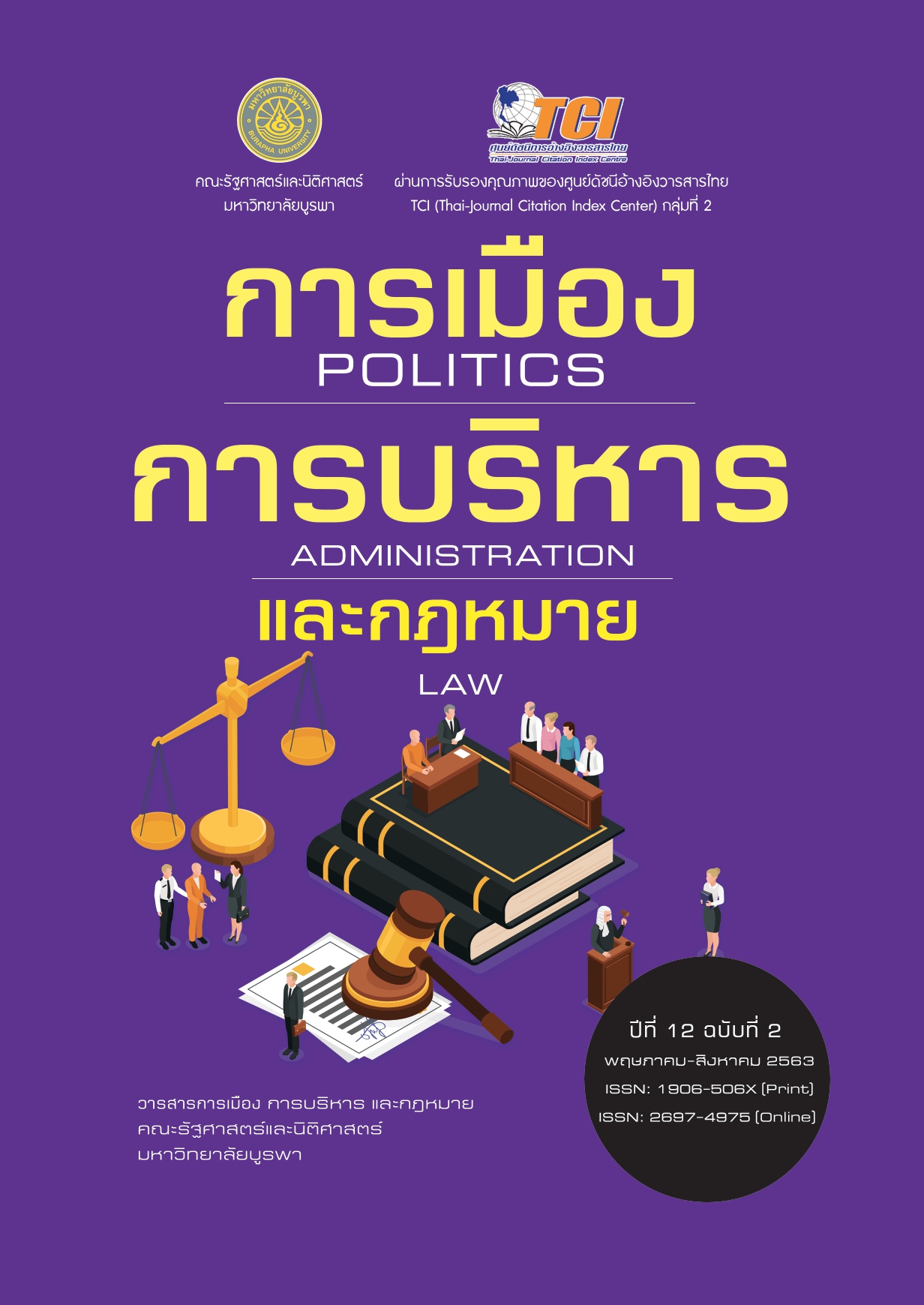รูปแบบความผูกพันต่อองค์การของพนักงานจ้างตามภารกิจในองค์กรปกครองส่วนท้องถิ่นภาคตะวันออกเฉียงเหนือตอนบน: กรณีศึกษาเทศบาลตำบล
คำสำคัญ:
ความผูกพันต่อองค์การ, พนักงานจ้างตามภารกิจ, องค์กรปกครองส่วนท้องถิ่น ภาคตะวันออกเฉียงเหนือตอนบน, เทศบาลตำบลบทคัดย่อ
การวิจัยนี้มีวัตถุประสงค์เพื่อ 1) ศึกษาระดับความผูกพันต่อองค์การของพนักงานจ้างตามภารกิจ 2) ตรวจสอบความสอดคล้องของรูปแบบความสัมพันธ์เชิงสาเหตุของปัจจัยที่มีอิทธิพลต่อความผูกพันต่อองค์การของพนักงานจ้างตามภารกิจกับข้อมูลเชิงประจักษ์ และ 3) ศึกษาค่าน้ำหนักอิทธิพลทางตรง อิทธิพลทางอ้อม และอิทธิพลรวมของปัจจัยเชิงสาเหตุที่มีอิทธิพลต่อความผูกพันต่อองค์การของพนักงานจ้างตามภารกิจ กลุ่มตัวอย่างจำนวน 600 คน สถิติ Path Analysis ตรวจสอบความสอดคล้องของรูปแบบกับข้อมูล เชิงประจักษ์และน้ำหนักของอิทธิพล ผลการวิจัยพบว่า 1. ความผูกพันต่อองค์การของพนักงานจ้างตามภารกิจอยู่ในระดับดีมาก 2. ผลการตรวจสอบความสอดคล้องกับข้อมูลเชิงประจักษ์ ผ่านเกณฑ์มาตรฐานที่กำหนดทุกดัชนี ดังนี้ = 0.261, df = 5, p-value = 0.998, CFI = 1.000, TLI = 1.015, RMSEA = 0.000, SRMR = 0.001 และ
/df = 0.052 3. เจตคติในงาน ลักษณะงาน ลักษณะองค์การ ภาวะผู้นำ ค่าตอบแทน ความสัมพันธ์ เพื่อนร่วมงาน การสนับสนุนจากผู้บังคับบัญชา ความพึงพอใจในงาน มีอิทธิพลทางตรง และอิทธิพลรวม ต่อความผูกพันต่อองค์การของพนักงานจ้างตามภารกิจ ที่ระดับนัยสำคัญทางสถิติ 0.05 ลักษณะงาน ภาวะผู้นำ และการสนับสนุนจากผู้บังคับบัญชา มีอิทธิพลทางอ้อมต่อความผูกพันต่อองค์การของพนักงานจ้างตามภารกิจโดยส่งผ่านความพึงพอใจในงาน
เอกสารอ้างอิง
กรมส่งเสริมการปกครองท้องถิ่น. (2559). ข้อมูลจากระบบศูนย์ข้อมูลบุคลากรท้องถิ่น (lHR) ณ วันที่ 30 กรกฎาคม 2560. กรุงเทพฯ: กรมส่งเสริมการปกครองท้องถิ่น.
กรรณิการ์ มณฑา. (2556). ยุทธศาสตร์การเสริมสร้างความผูกพันต่อองค์การของพนักงาน. มหาวิทยาลัยเกษตรศาสตร์ วิทยาเขตเฉลิมพระเกียรติ จังหวัดสกลนคร. วารสารบัณฑิตศึกษา, 10(50), 1-7.
กฤตธีรา คำภิธรรม. (2554). ปัจจัยที่มีอิทธิพลต่อความผูกพันกับองค์กรของพนักงานองค์กรปกครองส่วนท้องถิ่น อำเภอเกาะคา จังหวัดลำปาง. วิทยานิพนธ์บริหารธุรกิจมหาบัณฑิต, มหาวิทยาลัยราชภัฏลำปาง.
กัลยา สว่างคง และวิโรจน์ เจษฏาลักษณ์. (2559). อิทธิพลของการรับรู้การสนับสนุนจากหัวหน้างานและจากองค์กรที่มีผลต่อความตั้งใจในการลาออกจากงานผ่านความผูกพันด้านความรู้สึกต่อองค์กร. วารสารการจัดการสมัยใหม่, 14(1), 91-104.
ณัฏฐพันธ์ เขจรนันทน์. (2552). พฤติกรรมองค์การ (Organizational Behaviors). วันที่ค้นข้อมูล 25 มิถุนายน 2560, เข้าถึงได้จาก http://library.senate.go.th/document/Ext2552/2552600_0002.PDF
ณัทฐา กรีหิรัญ. (2550). การศึกษาความพึงพอใจในการปฏิบัติงานของพนักงานมหาวิทยาลัยศรีนครินทรวิโรฒ. สาขาวิชาการอุดมศึกษา, มหาวิทยาลัยศรีนครินทรวิโรฒ.
ดลนภา ดีบุปผา. (2555). ความสัมพันธ์ระหว่างวัฒนธรรมในองค์กร ความสัมพันธ์กับเพื่อนร่วมงานกับความผูกพันในองค์กรของพนักงานบริษัทเอบี ฟู้ด จังหวัดสมุทรปราการ. วิทยานิพนธ์ศึกษาศาสตรมหาบัณฑิต, มหาวิทยาลัยสุโขทัยธรรมาธิราช.
ธงชัย สันติวงษ์. (2538). พฤติกรรมองค์การ. กรุงเทพฯ: ไทยวัฒนาพาณิช.
ธัญพิชชา สามารถ และทิพวรรณ หล่อสุวรรณรัตน์. (2558). ความผูกพันต่อองค์การของบุคลากร เทศบาลในภาคตะวันออก. วารสารการเมือง การบริหาร และกฎหมาย, คณะรัฐศาสตร์และนิติศาสตร์ มหาวิทยาลัยบูรพา, 7(2), 391-427.
ธีระ กุลสวัสดิ์. (2554). การพัฒนาโมเดลเชิงสาเหตุของความผูกพันต่อองค์กรของบุคลากรในเทศบาล แหลมฉบัง. วารสารการเมือง การบริหาร และกฎหมาย, 3(3), 275-307.
ธีระพงษ์ ภูริปาณิก. (2552). ความผูกพันและความพึงพอใจที่มีต่อองค์การของบุคลากรเทศบาลตำบลบางพระ อำเภอศรีราชา จังหวัดชลบุรี. วารสารการเมือง การบริหาร และกฎหมาย, 2(2), 161-183.
นรุตม์ พรประสิทธิ์. (2554). ความสัมพันธ์ระหว่างคุณลักษณะของงาน ความพึงพอใจในการตอบสนองความต้องการพื้นฐานทางจิตใจตามทฤษฎีการกำหนดด้วยตนเองและความผูกพันในงาน: กรณีศึกษาบริษัทกลุ่มธุรกิจพัฒนา. วิทยานิพนธ์ศิลปศาสตรมหาบัณฑิต, มหาวิทยาลัยธรรมศาสตร์.
นุชราภรณ์ แพงสุข. (2556). ปัจจัยที่มีอิทธิพลต่อความผูกพันองค์การของบุคลากรเทศบาลตำบลในอำเภอเมืองบึงกาฬ จังหวัดบึงกาฬ. วิทยานิพนธ์บริหารธุรกิจมหาบัณฑิต, มหาวิทยาลัยราชภัฏมหาสารคาม.
ประคัลภ์ ปัญฑพลังกูร. (2552). ค่าตอบแทนกับการสร้างความผูกพันของพนักงานในองค์กร. วันที่ค้นข้อมูล 22 มีนาคม 2560, เข้าถึงได้จาก https://prakal.wordpress.com/2009/
ปรียาพร วงศ์อนุตรโรจน์. (2534). จิตวิทยาการศึกษา. กรุงเทพฯ: ศูนย์สื่อเสริมกรุงเทพมหานคร.
ปาริชาต บัวเป็ง. (2554). ปัจจัยที่มีผลต่อความผูกพันต่อองค์กรของพนักงานบริษัทไดกิ้น อินดัสทรีส์ ประเทศไทย (จำกัด). วิทยานิพนธ์บริหารธุรกิจมหาบัณฑิต, มหาวิทยาลัยเทคโนโลยีราชมงคลธัญบุรี.
พระราชบัญญัติระเบียบบริหารงานบุคคลส่วนท้องถิ่น พ.ศ. 2542. (2542, 18 พฤศจิกายน). ราชกิจจานุเบกษา. เล่ม 116 ตอนที่ 120 ก.
พิพัฒน์ วรสิทธิดำรง. (2555). สำรวจจากอัตราการว่างงาน สำรวจจากภาวการณ์ทำงานของประชากร ตั้งแต่ปี พ.ศ. 2551 - 2555. กรุงเทพฯ: สำนักงานสถิติแห่งชาติ กระทรวงเทคโนโลยีสารสนเทศและ การสื่อสาร.
มุกดา ศรียงค์. (2550). ภาวะผู้นำ: ลูกน้องเป็นสุข...งานสำเร็จ. วารสารพฤติกรรมศาสตร์, 13(1), 44-49.
มุทิตา คงกระพันธ์. (2554). การศึกษาอิทธิพลของการรับรู้ความสัมพันธ์ระหว่างบุคคล การรับรู้การสนับสนุนจากองค์กรผ่านความผูกพันต่อองค์กร และความพึงพอใจในงานที่มีต่อผลการปฏิบัติงานตามบทบาทหน้าที่. วิทยานิพนธ์ศิลปศาสตรมหาบัณฑิต, มหาวิทยาลัยศิลปากร,
วรัญญู พินทุสมิต. (2550). การบริหารค่าตอบแทนที่มีประสิทธิผล: กรณีศึกษาบริษัท ฮอนด้า ลิสซิ่ง (ประเทศไทย) จำกัด. วิทยานิพนธ์วิทยาศาสตรมหาบัณฑิต, สถาบันบัณฑิตพัฒนบริหารศาสตร์.
วันชะลี แก้วคง. (2548). ความผูกพันต่อองค์การของข้าราชการและลูกจ้างประจำที่ปฏิบัติหน้าที่ในพระราชวังบางปะอิน. วิทยานิพนธ์รัฐประศาสนศาสตรมหาบัณฑิต, มหาวิทยาลัยบูรพา.
ศิริญาพร ปรีชา. (2557). การศึกษาความผูกพันของบุคลากรต่อองค์กร กรณีศึกษาสำนักวิทยบริการ มหาวิทยาลัยขอนแก่น. วารสารอินฟอร์เมชั่น, 21(1), 1-11.
สถาบันราชานุกูล. (2559). ความผูกพันของบุคลากร ข้อมูลสถิติด้านบุคลากร ปี 2559. ศูนย์ข้อมูลสารสนเทศ. วันที่ค้นข้อมูล 26 ตุลาคม 2561 เข้าถึงได้จาก http://www.rajanukul.go.th/new/ index.php?mode=maincontent&group=337&id=5870&date_start=&date_end=
สนั่น เถาชารี. (2012). กลยุทธ์การบริหารค่าตอบแทน (Compensation Management). วันที่ค้นข้อมูล 6 มิถุนายน 2560,เข้าถึงได้ จาก http://www.thailandindustry.com/indust_newweb/ articles_preview.php?cid=17843
สมนันท์ สุทธารัตน์. (2556). ความสัมพันธ์ระหว่างสภาพแวดล้อมในการทำงาน ภาวะผู้นำของหัวหน้าหอผู้ป่วยกับความยึดมั่นผูกพันต่อองค์การของพยาบาลวิชาชีพรุ่นเจเนอเรชั่นวายโรงพยาบาลมหาวิทยาลัยในกำกับของรัฐ. วิทยานิพนธ์พยาบาลศาสตรมหาบัณฑิต, จุฬาลงกรณ์มหาวิทยาลัย.
สมพร เฟื่องจันทร์. (2547). แนวคิดและหลักการจัดการในองค์การสาธารณะ. กรุงเทพฯ: สำนักพิมพ์แห่งจุฬาลงกรณ์มหาวิทยาลัย.
สาธิต รื่นเริงใจ. (2549). ปัจจัยเชิงสาเหตุที่ส่งผลต่อความผูกพันต่อองค์การของครูโรงเรียนมัธยมศึกษา สังกัดสำนักงานคณะกรรมการการศึกษาขั้นพื้นฐาน. วิทยานิพนธ์การศึกษาดุษฎีบัณฑิต, มหาวิทยาลัยบูรพา.
หม่อมหลวงศิราภิรมย์ ธีรประเสริฐ. (2555). องค์ประกอบที่มีอิทธิพลต่อความพึงพอใจในงานและการผูกพันองค์การในองค์การธุรกิจภาคการผลิตที่ส่งผลต่อความตั้งใจลาออกจากองค์การของบุคลากรกลุ่มอุตสาหกรรมแฟชั่นที่มีสำนักงานในเขตกรุงเทพมหานคร. วิทยานิพนธ์บริหารธุรกิจดุษฎีบัณฑิต, มหาวิทยาลัยรามคำแหง.
อนุรัตน์ อนันทนาธร. (2551). การศึกษาความพึงพอใจและความผูกพันต่อองค์กรของบุคลากรเทศบาลตำบลบางพระ. วารสารวิชาการมนุษยศาสตร์และสังคมศาสตร์, 16(25-26), 57-72.
อนุศักดิ์ จิระจิตตานนท์. (2553). ความผูกพันต่อองค์การของพนักงานเทศบาลนครนครปฐม. วิทยานิพนธ์รัฐประศาสนศาสตรมหาบัณฑิต, วิทยาลัยการปกครองท้องถิ่น, มหาวิทยาลัยขอนแก่น.
อารยา นุ่มนิ่ม. (2552). การศึกษาพฤติกรรมการบริหารของผู้บริหารกับสภาพขวัญในการปฏิบัติงานของบุคลากรในมหาวิทยาลัยเทคโนโลยีราชมงคลล้านนา. มหาวิทยาลัยเทคโนโลยีราชมงคลล้านนา เขตพื้นที่พิษณุโลก.
Astakhova, M. N. (2016). Explaining the effects of perceived person-supervisor fit and person-organization fit on organizational commitment in the U.S. and Japan. Journal of Business Research, 69, 956-963.
Becker, H. S. (1960). Notes on the concept of commitment. The American Journal of Sociology, 66(1), 32-40.
Buchanan, B. (1974). Building Organizational Commitment: The Socialization of Managers in Work Organizations. Administrative Science Quarterly, 19(4), 533-546.
Button, C. (1973). Innovation: The Steps Beyond. Journal of The Association for Supervision and Curriculum Development: Educational Leadership, 30(6), 536-542.
Cheah, C. S., Chong, V. S. W., Yeo, S. F., & Pee, K. W. (2016). An Empirical Study on Factors Affecting Orangizational Commitment Among GenerationX. Social and Behavioral Sciences, 219, 167-174.
Colquitt, J. A., Lepine, J. A., & Wesson, M. J. (2013). Organizational Behavior: Improving Performance and Commitment in the Workplace (4 Edition). New York, NY: McGraw-Hill Education.
Currivan, D. B. (1999). The causal order of job satisfaction and organizational commitment in models of employee turnover. Human Resource Management Review, 9(4), 495-524.
Gaertner, S. (1999). Structural determinants of job satisfaction and organizational commitment in turnover models. Human Resource Management Review, 9(4), 479-493.
Hackman, J. R., III, E. E. L., & Porter, L. W. (1977). Perspectives on Behavior in Organizations. New York: McGraw-Hill Book Company.
Hair, J. F., Black, W. C. Babin, B. J., & Anderson, R. E. (2010). Multivariate data analysis: A global perspective (7th ed.). New Jersey: Pearson Education.
Lapointe, E., & Vandenberghe, C. (2017). Supervisory mentoring and employee affective commitment and turnover: The critical role of contextual factors. Journal of Vocational Behavior, 98, 98-107.
Meyer, J. P., & Allen, N. J. (1997). Commitment in the Workplace: Theory Research and Application. California: SAGE Publications.
Newstrom, J. W., & Davis, K. (1993). Organizational Behavior Human Behavior at Work (9th ed.). New York: McGraw-Hill, Inc.
Ozbag, G. K., & Ceyhun, G. C. (2014). The Impact of Job Characteristics on Burnout: The Role of Work Family Conflict and the Moderating Role of Job Satisfaction. International Journal of Academic Research in Management (IJARM), 3(3), 291–309.
Panitee K., & Petprakai K. (2018). Enhancement of Organizational Commitment of the Provincial Office of the Auditor General in the Northeastern Region, Thailand. The Sino-Thai International Symposium on Management. Conference Proceedings. Chongqing: China.
Porter, L. W., Steers, R. M., Mowday, R. T., & Boulian, P. V. (1974). Organization Commitment, Job Satisfaction, and Turnover Among Psychiatri Tehnicians. Journal of Applied Psychology, 59(5), 603-609.
Rhoades, L., & Eisenberger, R. (2002). Perceived Organizational Support: A Review of the Literature. Journal of Applied Psychology, 87(4), 698-714.
Shanhe J., Lambert, E. G., Xiaohong Jin, Deping Xiang, Mengfei Shi and Dawei Zhang. (2017). Correlates of Organizational Commitment Among Community Among Community Correctional Officers in China. The Prison Journal, 98(1), 60-82. Retrieved June 17, 2017 from https://doi.org/10.1177/0032885517743706






